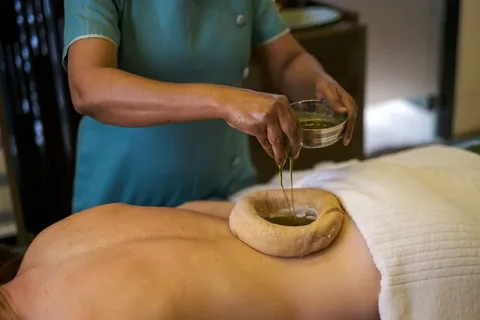What Role Does Massage Play in Ayurvedic Back Pain Therapy

Back pain is a common problem that affects people of all ages. Whether caused by poor posture, muscle strain, or stress, it can impact daily life and reduce overall comfort. Modern treatments often rely on painkillers or invasive procedures, but they may not address the root cause of the problem.
Ayurvedic medicine, an ancient system of healing from India, offers a natural and holistic approach to relieve back pain. Among the many therapies in Ayurveda, massage plays a central role. In this article, we will explore the role of massage in Ayurvedic back pain therapy, its benefits, techniques, and tips for maximum effectiveness.
Note: Ayurvedic Treatment for Back Pain in Marina Expert Ayurvedic therapies in Marina help relieve back pain naturally, improve flexibility, and restore overall body balance through herbal oils, massage, and yoga.
Understanding Ayurvedic Massage

What Is Ayurvedic Massage?
Ayurvedic massage, also known as Abhyanga, involves the application of warm herbal oils on the body with specific techniques. The oils are infused with herbs chosen according to the patient’s dosha (body type) and the nature of the problem.
The goal of Ayurvedic massage is to:
- Relax tense muscles
- Improve blood circulation
- Reduce inflammation
- Balance the body’s doshas
How Massage Fits Into Back Pain Therapy
Back pain in Ayurveda is often linked to an imbalance in Vata dosha, which governs movement, nerves, and joint flexibility. Massage helps calm Vata, relieve muscle stiffness, and support natural healing.
Benefits of Ayurvedic Massage for Back Pain
1. Reduces Muscle Tension
Muscle stiffness is a major contributor to back pain. Ayurvedic massage:
- Loosens tight muscles
- Increases flexibility
- Relieves discomfort caused by prolonged sitting or physical strain
2. Improves Blood Circulation
Proper blood flow is essential for healing. Massage:
- Delivers oxygen and nutrients to affected areas
- Removes metabolic waste
- Promotes faster recovery from muscle and tissue damage
3. Reduces Inflammation
Herbal oils used in Ayurvedic massage have anti-inflammatory properties. They help reduce swelling and calm irritated nerves, which is essential for easing back pain.
4. Relieves Stress and Promotes Relaxation
Stress can worsen back pain by increasing muscle tension. Ayurvedic massage:
- Activates the parasympathetic nervous system
- Reduces stress hormones
- Encourages deep relaxation and better sleep
5. Enhances Flexibility and Mobility
Regular massage keeps the back muscles supple and prevents stiffness. It improves joint mobility, which reduces the risk of future injuries and chronic pain.
Types of Ayurvedic Massage for Back Pain
1. Abhyanga (Full-Body Herbal Oil Massage)
Abhyanga involves massaging the entire body with warm herbal oils. For back pain:
- Specific techniques target the spine, lower back, and shoulder areas
- Oils like Mahanarayan Oil and Dhanwantharam Oil are commonly used
- Helps in relaxing muscles, improving circulation, and calming nerves
2. Pizhichil (Oil Pouring Therapy)
Pizhichil involves gently pouring warm herbal oil over the back while massaging. Benefits include:
- Deep penetration of herbs into tissues
- Relief from chronic stiffness and pain
- Balancing Vata dosha for natural healing
3. Kizhi (Herbal Poultice Massage)
Kizhi uses heated herbal pouches applied to the back. These poultices:
- Reduce inflammation and swelling
- Soothe muscles and joints
- Promote circulation and detoxification
4. Shirodhara (Oil Drip Therapy)
Although primarily used for stress and mental balance, Shirodhara can indirectly help back pain by:
- Reducing stress and tension in the nervous system
- Improving sleep quality, which supports healing
- Calming the mind and body for better recovery
How Often Should Massage Be Done?
Initial Treatment Phase
For acute back pain, daily massage sessions may be recommended for 1-2 weeks to relieve stiffness and pain.
Maintenance Phase
After the initial relief, 2-3 sessions per week can help maintain flexibility, reduce stress, and prevent recurrence.
Personalized Approach
The frequency and type of massage depend on:
- Severity of back pain
- Dosha imbalance
- Overall health and age
Consulting an experienced Ayurvedic practitioner ensures the best plan for your needs.
Complementary Lifestyle Tips for Better Results
1. Maintain Proper Posture
Avoid slouching while sitting or standing. Ergonomic chairs and supportive cushions help reduce strain on the back muscles.
2. Follow an Ayurvedic Diet
Eat warm, cooked foods that are suitable for your dosha. Avoid cold, processed, and heavy foods that increase Vata. Include anti-inflammatory herbs like turmeric, ginger, and garlic.
3. Exercise and Yoga
Gentle yoga and stretching exercises complement massage therapy by:
- Strengthening back muscles
- Improving flexibility
- Reducing recurrence of pain
4. Stress Management
Stress contributes to muscle tension. Practice meditation, deep breathing, or relaxation techniques to support overall therapy.
Final Thoughts
Ayurvedic massage plays a central role in back pain therapy. It not only relieves pain and stiffness but also improves circulation, reduces inflammation, and promotes relaxation. By combining massage with lifestyle adjustments, yoga, and a dosha-specific diet, you can achieve long-term relief from back pain naturally.
Unlike quick-fix treatments, Ayurvedic massage addresses the root causes of back pain, restores balance to the body, and enhances overall well-being. For anyone suffering from chronic or occasional back pain, Ayurvedic massage offers a safe, holistic, and effective solution.
Investing in this therapy is an investment in your health, comfort, and quality of life.
For more insightful articles related to this topic, feel free to visit: viewpen.online


